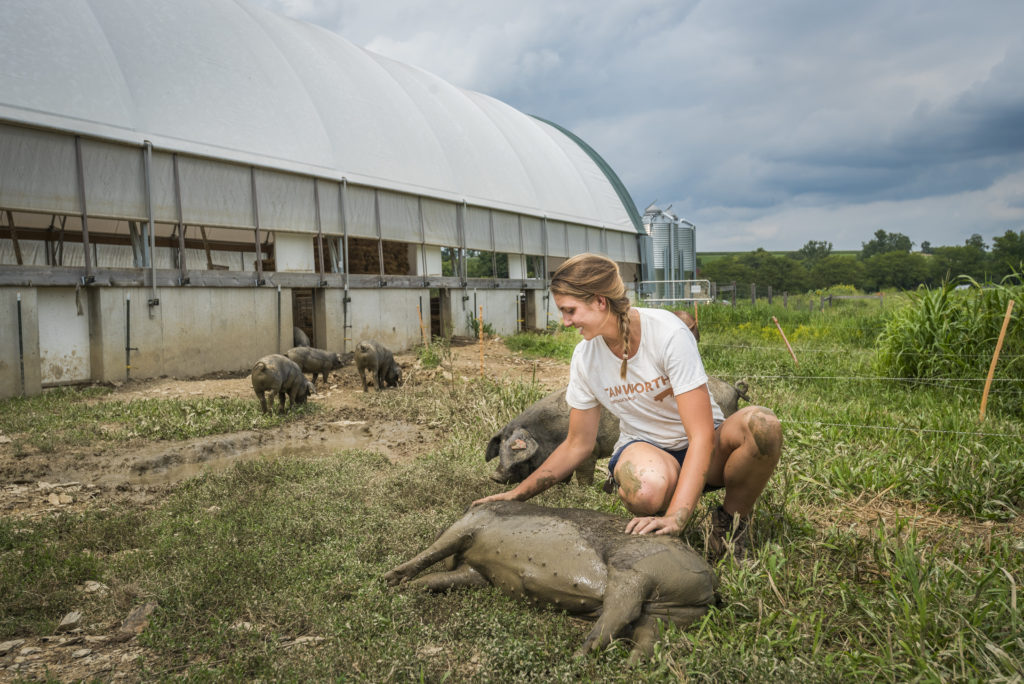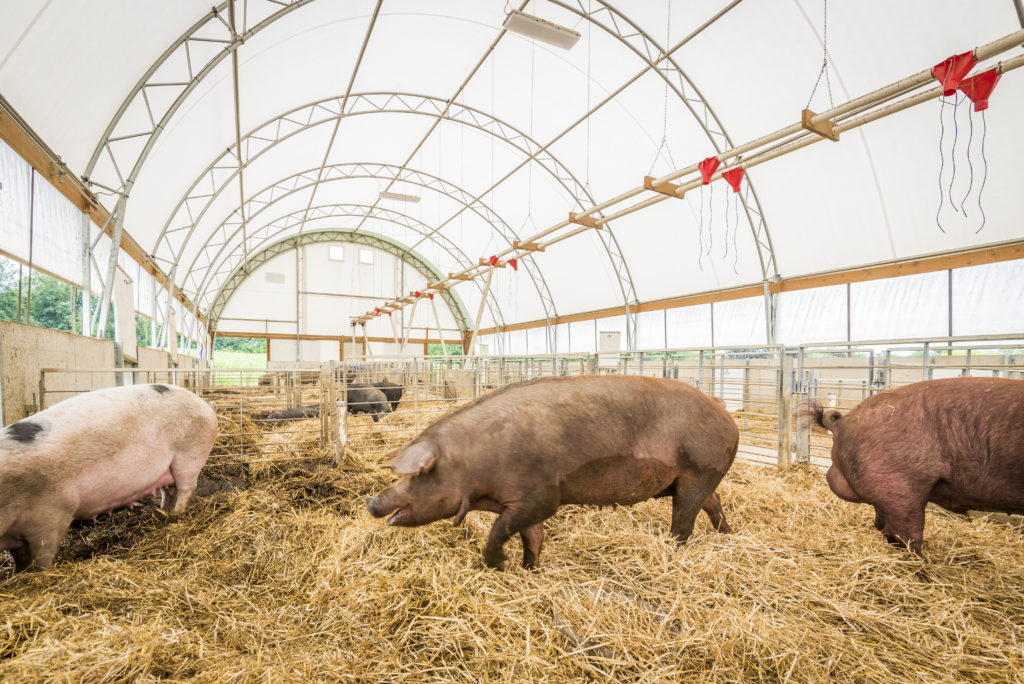This article originally ran in the fall 2017 issue of New Farm Magazine, the magazine of Organic Farmers Association. All OFA members receive a complimentary issue of New Farm twice per year. Click here to sign up!
The animals tend to be healthier and less stressed than those raised in confinement, while pastured pork sells for premium prices. But pasturing pigs involves more than just opening the barn doors and letting them out. A variety of challenges can disrupt the process. We asked Rodale Institute and other organic farmers to share the strategies they’ve learned from their experiences.

Weather Protection
Temperature extremes, chilling winds, and wet conditions can threaten the animals’ health. Piglets are particularly vulnerable. With the right timing of your production cycle, however, you can minimize the risks, says Ross Duffield, farm manager at Rodale Institute in Kutztown, Pennsylvania. By breeding sows to farrow in the spring or the fall, you never have tiny piglets to protect during cold, wet weather or summer heat, he explains.
At BeeWench Farm in Shandon, California, Sarah Ziegenbein avoids having to deal with pigs during the rainy season by buying feeder pigs in the early spring and sending them all to the processor in the fall. Since the weather is never cold and rarely wet while Ziegenbein has pigs on pasture, she only needs to provide inexpensive sun shelters to supplement her existing shade trees.
The Rodale Institute team found that small wooden A-frame buildings positioned on skids and sized to shelter a dozen pigs held up well when moved from pasture to pasture. But larger operations need more shelter space, and managing many small shelters is time consuming. That’s why Rodale Institute erected a permanent central shelter that provides cool, well-ventilated protection from the heat of the summer and dry, well-ventilated protection during the winter. Inside the hoop house structure are 11 deeply bedded stalls. The pigs can come and go at will to sections of pasture linked to their stalls. Low sidewalls prevent drafts, and rollup sides and a high ceiling allow for air movement. A white roof tarp shades without trapping heat, keeping the shelter remarkably cool and nearly odor free, even on hot days. The structure houses about 100 hogs a year, but the design can be adapted to handle up to 300.
Clean Bedding
Deep, dry, loose bedding helps pigs keep warm and soaks up urine and wetness from manure, preserving the nutrients for later composting and cutting down on odors (and flies). Getting soiled material out of buildings requires labor, but good planning can minimize that.
The Rodale shelter has a poured-concrete floor that is designed to make cleaning simple. A central walkway sits 5 inches above the main pen level, which is lined with loose straw and spot-cleaned daily. Another 5 inches down is an area where dirtied bedding is allowed to build up. Twice a year all of the building’s panel walls in the lowest area are removed, and two people spend no more than four hours scooping the accumulated manure and used straw up with a loader, pushing it out the door, and sending it off to the composting heap in trucks.

Water Access
Pigs need a constant supply of clean, cool water, but standard troughs get dirty or turn into pools for the animals. The solution for Mike Hansen of Good Earth Farms in Milladore, Wisconsin is a towable platform that he moves with his pigs. It has nipple waterers mounted in the center. Rodale installed permanent frostproof nipple waterers in each of its pens, and the pigs come in whenever they want a drink.
Efficient Feeding
Pasturing reduces the amount of feed that farmers must provide, but it doesn’t eliminate the need for feeding altogether. Rodale has cut both labor costs and waste by installing an automated system. Bulk feed is delivered into outside storage bins, and an overhead auger system carries it to each indoor pen, where a human dispenses the desired amount. The system has almost no waste or spoilage, and it allows one person to feed a herd of pigs easily and efficiently— no lifting of heavy bags is necessary.
Herd Control
Portable electric fencing is the backbone of most successful pastured-animal operations. It works well for pigs, but only if you teach them to respect it early and firmly. Most animals jump back when shocked, but pigs jump forward, so you can’t train them with just electrified wires. Rodale begins working with piglets as soon as they start exploring the pasture. The farrowing pasture is surrounded by a semipermanent wire mesh fence, and 6 inches inside that are fiberglass posts that support a hot polywire (set at chin height for the piglets). For older pigs, you need a sturdy hog-panel enclosure and a couple of hot wires set on posts 6 inches inside that. Once the pigs are familiar with the pen’s restrictions, you need only one or two hot polywires (set at chin height and back height) on posts to keep them in place, explains Shelby Dukes, Rodale Institute’s animal husbandry coordinator.
Marc Michini of Purely Farms in Pipersville, Pennsylvania, uses electrified sheep netting for very young pigs, as it is easy to move. Once pigs start rooting, they quickly bury netting fences and escape over the mounds they’ve made on top of them, so he switches to two strands of polywire on step-in posts.
Herding or catching uncooperative pigs can be hard, frustrating work. Dukes has found a strategy that helps her lure and lead the pigs where she needs them to go. “Feed your pigs treats on a regular basis,” she says. “They love to eat sweet fruits and veggies.” That makes for happy pigs and farmers.
Learn more about Rodale Institute’s pastured-hog operation and watch a video here. To learn more about Rodale Institute’s organic livestock management, click here.
